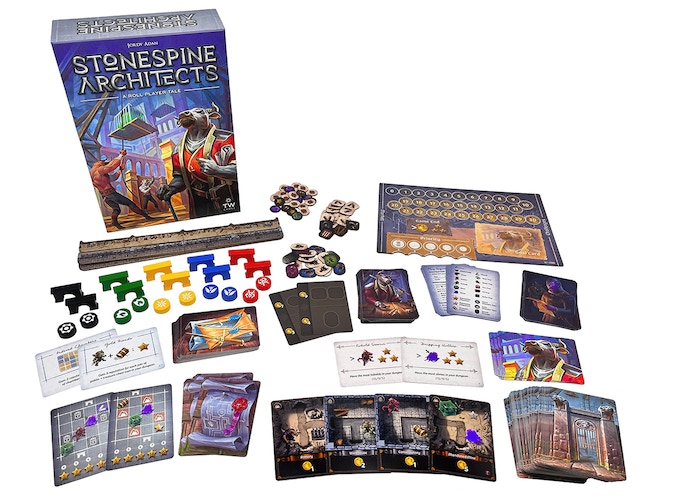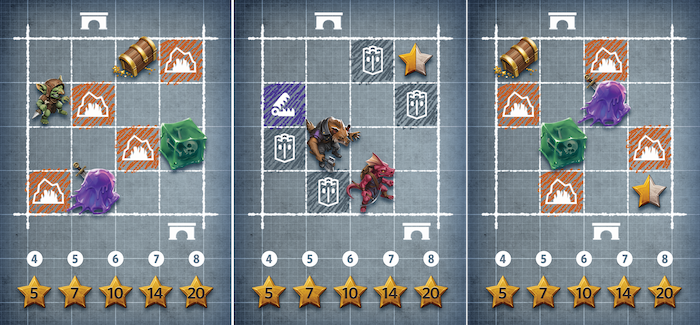Stonespine Architects

About Stonespine Architects:
Stonespine Architects, designed by Jordy Adan and published by Thunderworks Games, is a drafting game where players compete to build the greatest fantasy dungeon.
Each round, players draft 4 new chambers to add to their dungeon, competing for public and private scoring that changes every game. They spend gold between rounds to customize their labyrinth with monsters, traps, treasures, and secret passages. At the end of four years, the player with the most treacherous dungeon will earn the title of Master Architect!
Project Overview:
Development on Stonespine Architects was focused on ramping up the tension in player decisions during the card draft, and to expand and refine the game's variable scoring content.
We also designed a new solo mode and a small promotional pack for the game's Kickstarter campaign.
Services Provided:
- Playtest Coordination and Analysis
- Gameplay Streamlining
- Solo Mode Design
- Content Design
Development Diary: Texturing Decisions
The core components of Stonespine Architects are its 100+ draftable Chamber Cards and the 32 Challenge Cards used for scoring. Throughout development, we tested many variations on these cards to improve the decision-making and scoring experience for the players as they chose cards and built their dungeon layout.
Part of what makes Stonespine Architects unique is that by default, almost NOTHING on the cards scores points. Cards contain elements such as various monsters, traps, and pathways that only provide points at the end of the game if the player collects "Challenge Cards" to make them do so. Though their point values are obscured from the player, we tuned the frequency of these icons and the combinations in which they appear to ensure an interesting draft experience and balanced endgame scoring.

Players compete to select these Challenge cards during a market phase at the end of each round, using resources obtained through cards they drafted that round. Each Challenge card tells the player to care about quantities of room elements, spacial relations in the dungeon, or a combination of both, and we had to develop them in such a way that let them simultaneously synergize and be at opposition to each other to ensure card drafting remained interesting.
Because icons aren't worth anything by default, we wanted to give players reasons to compete and evaluate card choices from the very beginning of the game. This led to the implementation of public goals: scoring available to everyone from the start of the game.
The first iteration of this was to have two public goals:
- One cared about spacial aspects of player's dungeons such as paths and room clusters
- The other cared about collecting quantities of certain monsters and traps.

We found that with all of the other visible information in the market, personal challenge cards, and opponents' dungeons, it was too much information to have two public goals. We merged the idea into a single deck of public goals, with objectives easy enough to remember, and rewards large enough to be important. Later, additional development from Keith Matejka refined these cards into the final set of goals in the game.
Building the Path
The central theme and promise of Stonespine Architects is that players build a twisting, Theseus and the Minotaur-style labyrinth. But in the initial design, there was no core rule about players' labyrinths having to be a connected, logical structure — so players often ended up feeling like they hadn't really "built" a dungeon.
We tried always putting a public goal related to the labyrinth's layout, but as we mentioned above, it was ultimately better to have one, varied deck of public goals.
So the problem was still there: How do we make players care about dungeon layout in every game? How do we make this a core part of a labyrinth building game?

The only other element that all players shared at the start of the game were the Blueprint Cards - which gave bonus points based on putting certain room types or monsters/traps in a specific slot in their dungeon. It made a lot of sense to try tackling this through the Blueprints.
We tried a few different things, such as implementing a specific entrance/exit and scoring players' ability to properly connect them. As we went down this path, we settled on something easy to understand and remember, and score at game end:
- Each room in your dungeon connected to the entrance is worth 1 point.
- Each room in your dungeon connected to the exit is worth 1 point.

Our main goal going into development was to increase the tension and texture of the game. When it was initially passed in, players mostly kept to their own dungeons as they chose the best rooms, followed by the best goal cards for themselves. Now that the game is finished, players have more dimensions to analyze on every card pick, but hopefully without over-taxing themselves.
Brieger Creative Team
- John Brieger
- Breeze Grigas